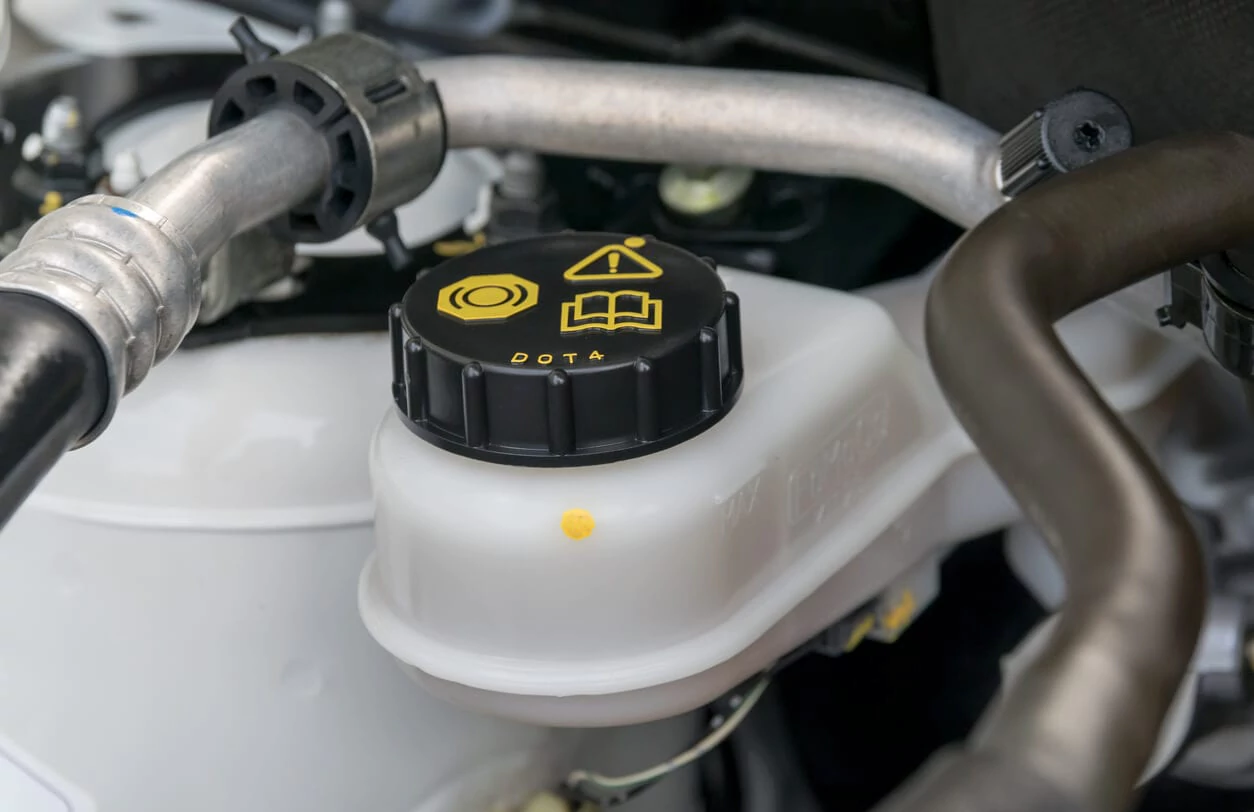Brake oil is one of the most critical fluids in your car, and it can directly impact the safety of riders. If you’re looking to do a brake oil change yourself, this 8-step guide can help. In addition to that, we’ll also discuss the frequency and symptoms of a brake oil change.
So, without any further ado, let’s get started!
Why Do You Need to Change the Brake Oil? How Often Should You Do It?
Brake oil, also known as brake fluid, is a hydraulic fluid that transmits pressure from the master cylinder to the brake calipers, pushing the brake pads against the rotors. Brake fluid is hygroscopic, meaning it absorbs moisture over time, which can lower its boiling point and lead to reduced braking performance, potentially compromising your safety.
Depending upon your driving habits and external conditions, you should change the brake at least every three years or after 45,000 miles (72,000 km). However, you must check the brake oil levels after every six months or 10,000 miles (16,000 km). You should always refer to your car’s owner’s manual to know the exact interval of the brake oil change.

What are the Symptoms that You Need to Change the Brake Oil?
Here are some common symptoms that you need to change the brake oil:
- Low brake oil level
- Brake warning light lit up on the dashboard
- Spongy or soft brake pedal
- Increased stopping distance
- Brake pedal going to the floor
- Vehicle pulls to one side
- Yellowish or brownish puddles under your vehicle
- Burning smell after heavy braking
- Unusual noises, such as grinding or squeaking, while braking
- Dirty or discolored brake oil appearance

8 Easy-to-Follow Steps to Change the Brake Fluid
Once you have determined that the brake oil in your car needs to be changed, here’s how to do it:
Step#1: Gather Supplies
Before you begin, ensure you have the following supplies:
- New brake fluid (DOT 3, DOT 4, or DOT 5) as specified in your vehicle’s manual
- Brake bleeder kit
- A line wrench (usually 8mm or 10mm)
- Clear tubing
- Container to catch the old brake fluid.
- Gloves and safety goggles
- Rags or paper towels for cleanup
Step#2: Flush Brake Calipers/Wheel Cylinders
Next, you need to drain the old brake fluid. You must flush the brake calipers/wheel cylinders to do this. Starting with the brake caliper farthest from the master cylinder (usually the rear passenger side), attach the clear tubing to its bleeder valve and place the other end in a container. Locate the bleeder nipple on the back of each caliper and release it to let the fluid out.
Step#3: Empty Master Cylinder
Now, locate the master cylinder, which is usually a reservoir under the hood near the firewall. Start by removing the cap from the master cylinder reservoir. If any fluid remains, repeat the draining process to empty the master cylinder.
Step#4: Fill in Fresh Brake Fluid
Once the master cylinder is empty, fill it with fresh brake fluid. A standard car only needs about a quart of brake fluid, but check your vehicle’s specifications for the exact amount.
Step#5: Bleed the Brakes
With an assistant or using a brake bleeder kit, open the bleeder valve while the assistant presses the brake pedal. Close the valve before they release the pedal. Repeat this process until you see clear, new brake fluid flowing through the tubing, free of air bubbles.
Step#6: Top Up
After bleeding each caliper, check the brake oil level in the master cylinder and add more fluid if necessary to bring it back to the “full” mark.
Step#7: Repeat the Process for Other Calipers
Repeat this process for the remaining calipers, starting with the one closest to the master cylinder. This will ensure that all the old fluid is removed from the system.
Step#8: Safety Check
Once all calipers have been bled and the master cylinder is topped up, replace the master cylinder cap securely. Test the brake pedal for firmness before driving. It should feel solid and responsive. If it feels spongy, there may still be air in the system. Also, check for leaks around the bleeder valves and the master cylinder.
Frequently Asked Questions
1. How long does it take to change the brake fluid?
Changing the brake fluid completely can take between 30 and 90 minutes. Adding the new brake fluid is pretty simple; however, the bleeding procedure can take longer. The total time will depend on the mechanic’s skill and the type of the braking system. In some high-end cars with specialized brakes, the process might take longer.
2. How much does it cost to replace the brake fluid?
It will cost somewhere between $50 to $150 to replace the brake oil of a car. The total brake oil change cost depends on the quality of the fluid and the type of repair shop you’re visiting. More than 70% of the total replacement cost goes into labor since brake fluid itself won’t cost more than $20 in most cases. As far as the labor goes, a regular repair shop will charge you $40-$60 an hour for this, whereas a dealership or skilled mechanic may charge you up to $100 an hour.
3. How to check the brake fluid level?
To check the brake fluid level in your car, locate the brake fluid reservoir, usually found under the hood near the firewall. The reservoir will have markings indicating the minimum ‘min’ and maximum ‘max’ fluid levels. Check the fluid level against these markings.
4. What happens if you don’t change the brake oil on time?
If you don’t change the brake oil on time, your brakes may become less responsive, requiring more pressure to stop the car. Contaminated brake fluid can corrode the system components, leading to costly repairs. In severe cases, the brake system can fail completely, putting your life and the lives of your loved ones in jeopardy.
5. Why is my brake oil leaking?
There are several reasons why your brake oil might be leaking. One common cause is worn or damaged brake lines. Over time, brake lines can become corroded, cracked, or punctured, allowing brake fluid to leak. Another possibility is a faulty brake caliper. If the seals in the brake caliper are damaged or worn, brake fluid can leak out around the piston. Additionally, a loose or damaged brake hose can also lead to brake fluid leaks.

Final Word: Brake Oil Change
So, there you have it 8 steps to change the brake oil of any car. It is imperative that you carefully execute all the steps. If you feel you don’t know what you’re doing anywhere along the way, it’s better to consult a professional mechanic. The car’s braking system is not something you should take risks with; it puts you and your loved ones at risk.
Looking to import cars from China? We can help. GuangcaiAuto is your partner in importing reliable and efficient Chinese cars of all categories.
We offer cars from 60+ worldwide auto brands. With our efficient shipping and streamlined import process, bringing your dream car to your doorstep is easier than ever.
Get in touch with our sales team for more information, and don’t forget to explore our blog for the latest news and offers from the Chinese car market.


